9 aug 2015
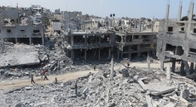
Gaza's Beit Hanoun following an Israeli attack in August 2014
“I have written this book as a way of preserving and passing on stories that need to be told.”
I visited North Vietnam in 1968, and had meetings with its leaders in the midst of the ongoing war, which resulted in receiving the outlines of a proposal for ending the conflict on a basis more favorable to the United States than what was finally negotiated by Henry Kissinger seven years and many deaths later. Because I was among the early anti-war visitors to Hanoi and may have been the first with a combination of academic credentials and some access to American decision-makers, there was great journalistic interest in my experience. I was approached on my return by mainstream journalists from major newspapers and TV networks, especially those who harbored growing doubts about the war, resulting in a series of interviews given prominent media attention for several days.
Yet I was deeply disappointed and disturbed by the experience, and the journalistic ethos that it revealed. The mainstream interest was totally focused on what I had been told by the North Vietnamese leadership about their receptivity to a peaceful resolution of the conflict. This preoccupation was, of course, understandable, but what I found so distressing at the time was a total disinterest in my accounts of the total vulnerability of the Vietnamese people to the onslaught of high tech weaponry, the resulting suffering and devastation, as well as the absence of military targets in the Vietnamese countryside, where the only structures were churches and hospitals.
I was deeply affected by this exposure to the human fabric of warfare, as well as by the Vietnamese spirit of resilience and perseverance coupled with an absence of bitterness toward the American people, in part a reflection of the way Vietnam was governed at the time. School children were taught that it is not contradictory to view the government of the United States as an enemy and yet maintain friendship with American people and the best of their national traditions. Throughout the war, I found it remarkable that Vietnamese school children were taught to regard the American Declaration of Independence as a step toward human liberation that deserved universal affirmation.
What I encountered in Europe and the United States when I tried to convey these impressions to journalists, especially those who were unashamedly liberal in their critical outlook toward the war, was a total disinterest in the (in)human face of the Vietnam war. Their concerns were confined to the realist agenda about how the war was going and whether the Vietnamese were serious about their posture of seeking peace via diplomacy on the basis of a political compromise rather than through victory on a battlefield outcome. The more I reflected on this, the more I came to realize that the journalistic ethos as applied to foreign policy was indifferent to the wartime suffering of the enemy population and a humanitarian catastrophe of massive proportions.
This deep seated indifference had several components. Above all, it reflected the nationalistic limits of empathy, which highlights sufferings of our side, and essentially ignores the losses of the other side, an extension of the friends/enemies dichotomy that underlies the realist paradigm. At most, the losses of the enemy other will be reported as statistics, but except in rare circumstances, without much human context to exhibit the terrible impact of war on the civilian population of a country that is subject to the sort of one-sided onslaught that afflicted Vietnam for so long.
A second explanation had to do with the imperial mentality that dominated Western journalism whether liberally inclined or not, which dissented from the war not because it violated the UN Charter or international law or was an affront to fundamental morality, but either because it was not producing a victory or was not worth the cost in American lives and resources. It is this realist calculus that is filtered through a nationalist optic that helps understand the peculiar form of liberalism that prevails in the United States and endorses the pernicious postulates of ‘American exceptionalism.’
A third explanation had to do with the overt commitment of Western mainstream journalism to a style of reportage based on facts, nor feelings or opinions, both of which are distrusted because of their supposedly subjective character. The primary journalistic claim in this tradition of professionalism is ‘the news without spin.’ In this respect, my post-Vietnam interviewers were acting ‘professionally’ given this canon, as any display of empathy for Vietnamese suffering would be discrediting to their claims to stand outside the circle of controversy when reporting the news. Not that such disengagement was unbiased, hiding rather than acknowledging its nationalist and realist framings.
All of which brings me to Mohammed Omer’s extraordinary Shell-Shocked: On the Ground under Israel’s Gaza Assault, published by Or Books (New York & London) in 2015.The book consists of dispatches from the war zone by a young prize-winning journalist who has been telling the world about the Gaza ordeal for almost ten years, since his early 20s. Omer’s prior reporting earned him the Martha Gellhorn Prize for Journalism in 2007, recognizing the excellence of his reportage on Gaza (‘a voice for the voicelss’). After receiving the award in The Netherlands, Omer on his return home received a brutal reception at the Gaza border by Israeli security guards, being beaten so severely as to endure serious injury that required specialized surgery. With the help of a Dutch diplomat and medical treatment Omer restored his health while studying in overseas universities, yet opting to return to Gaza rather than to enjoy a life abroad as an honored exile. Omer wrote this book while doing his best during the 51 day war of 2014, what Israelis called Operation Protective Edge, to tell the world about the war from the perspective of those enduring it, that is, the civilian population of Gaza. Shell-Shocked raises many issues worthy of commentary, but here I will limit myself to issues bearing on the style and ethics of professional journalism.
In essence, Omer does not have the option of detachment from the ordeal of war in the manner of the liberal journalists, who I describe above as covering the Vietnam war, as an instance of failure for American foreign policy. Omer by choice and circumstances refused to be detached, but that does not mean that he cannot be trusted. On the contrary. As Omer explains, “..I’m a journalist, and I owe it to my people and the Israeli people to get to the truth. I choose to stay in Palestine, my beloved home, with my wife, son, mother, father, siblings. I am not willing to let Israel or Zionism exterminate me.” He has a Dutch passport, and could leave, and lament the fate of Gaza from afar, and who could blame him for doing so. Obviously, the choice is not an easy or simple one. He observes at one point, “I wish I could airlift my wife and son (3 months) out of here. But this is my ancestral home; what else can I do?” In describing the effects of the war, Omer minimizes his own struggle to stay alive, courageously confronting life-threatening dangers on an hourly basis so as to fulfill his role as the eyes and voice of the Palestinian people enduring the ultimate horrors of war.
Part of what separates Omer from even the most empathetic of foreign journalists, for instance Max Blumenthal, is his embeddedness in the history and realities of life in Gaza. Even if he were to leave, his family would be surviving under the heavy weight of the Israeli assault. He can never escape emotionally from his deep attachment to Gaza. Again, his words are the best evidence of the authenticity and importance of his journalistic witnessing: “..I am offended, not only as a human, as a Palestinian in Gaza and as a father, but also as a journalist in Gaza. To get a story, I navigate a sea of body parts and blood each day, much it the remnants of people I know: my neighbors, friends and community. Unlike international reporters, those of us from Gaza don’t simply report. We live and die here.” Of course, the last part of this passage is not entirely fair.
Many brave international correspondents have risked their lives and paid the highest price on some occasions. I recall the great French reporter, Bernard Fall, being blown up by a mine while walking on a Vietnam beach, or more recently, the grisly 2014 TV beheading of the American journalist, James Foley, but Omer’s distinction still generally holds. The outsider who enters such a cauldron of political violence puts his life at risk, yet in almost all circumstances, can after awhile withdraw from the combat zone, resuming normalcy, although some journalists are subject to a kind of ‘fever of war,’ and only feel truly human when in the close vicinity of mortal danger. I remember Peter Arnett telling me in Hanoi on my second trip there in 1972 that after covering many major wars he only felt fully alive when doing first-hand war journalism, but the New Zealand born Peter, although animated and brave, never allowed the suffering of the civilian population to get to him, managing a detachment in the Western style, supposedly letting the facts do all the talking.
In important respects, this is also what Omer does, but with an undisguised sharp normative edge. The book consists of describing the daily ordeal experienced by the citizens of Gaza living under the fury of the Israeli attacks with no way of finding secure sanctuary, often relying on their own words to give the details of their struggles for survival and to recount their harrowing loss of loved ones. In this spirit Omer makes the reader almost feel what it must be like not to find food on the shelves of the neighborhood store or not to afford the spike in prices that follows from growing scarcities, or not to have safe drinking water for growing children or not to be able to escape the confines of one’s house, which is itself never out of the danger zone. And most of all, what it feels like to cope with the unspeakable death and maiming of family members and neighbors as a result of Israeli military tactics. These graphic descriptions of what the 51-day war meant for specific residents of Gaza constitutes the basic reportage of Shell-Shocked.
One expects that within this frame of witnessing Omer reports as accurately as possible, without exaggeration or invention. From what I know of Omer (he is a friend who I have known and admired for seven years) and of the situation in Gaza from other sources, I am utterly convinced that Omer is adhering to the highest standards of accuracy in reportage, relying heavily on descriptions of the scene and the witness of those who have endured the worst losses of loved ones, homes, livelihood. As well, his local affiliations are neutral. Omer does not belong to or identify with any political party or association. He is embedded in Gaza by life circumstances, being a member of the victimized society with deep family and community affinities, and by this identity disposed toward ending the occupation of Gaza, achieving self-determination for the Palestinian people, and the achieving a durable and just peace for both peoples.
Omer never pretends that he has no personal stake in this conflict. In introducing his book Omer gives the reader a sense of his outlook: “As for myself, I try to remain optimistic, no small feat in ruined shell of what was once a beautiful and self-sufficient coastal enclave. Our reality is predicated upon Israel’s determination to drive us from our homes for good.” More than this, Omer observes critically that “[v]ery few in the mainstream media ever talk about the right of the people of Gaza to defend ourselves, or even just to exist.” Note in the tangled syntax of this sentence that Omer gets trapped between describing the right that pertains to the people and a right that belongs to himself as one of the people. Making his political viewpoint even clearer, and from the Western journalistic ethos unacceptable, Omer acknowledges his support for BDS as raising the costs of occupation for Israel, and besides being a tactic that is lawful and nonviolent. Omer also affirms the inclusiveness of his hopes: “Speaking personally I would like to see a single state where equity and tolerance are the only way forward for Israelis and Palestinians.”
Omer also makes it clear that Israel understands that from its perspective that such journalistic depictions of the effects of the war both complicate and even undermine their propagandistic portrayals of good versus evil. Omer quotes a Beirut-based TV camera man, Abed Afifi, who reacts to the intentional targeting of a journalistic colleague with these words: “Such [an] attack is meant to intimidate us. Israel has no bank of targets, except civilians and journalists.” He goes on to insist that “[A]ll these attacks on civilians should not stop us from working—the world has to see what Israel is doing in Gaza.” And so it has to some degree, thanks to the efforts of Omer, Afifi, and many others.
Given the Israeli use of precision missiles against clearly marked TV vans, the inference of deliberate targeting seems hard to avoid. Israel has half acknowledged this by claiming that the journalists targeted are not ‘legitimate journalists,’ a claim refuted by Sarah Leah Whitson of Human Rights Watch, pointing out that such an attack is a violation of international humanitarian law even if the journalists can be shown to be partisan. In effect, the subjectively motivated journalist is by choice and hostile perception a kind of warrior, seeking to help win that part of the war, often the decisive part, waged for control of the psychological terrain governing ‘hearts and minds,’ and hence ‘illegitimate’ in the eyes of the side relying on a military onslaught to impose its will.
Finally, I return to my central comparison between objectively styled journalism that prevails in the West and the subjectively styled approach taken by Mohammed Omer and other journalists who work from a vantage point within the orbit of extreme victimization. I recall my friend, Walden Bello, the noted author and political figure from the Philippines, saying that he didn’t have to determine whether imperialism was real or not as he experiences its reality on a daily basis, which shaped and conditioned his observational standpoint. For Omer, the reality of violent oppression does not have to be determined as it is experienced in the most intense possible ways.
Some years ago, in collaboration with Howard Friel, I was the junior co-author of two books highly critical of the manner in which the New York Times handled foreign policy debates and reported on Middle East issues, especially the Israel/Palestine conflict. [The Record of the Paper: How the New York Times Misreports U.S. Foreign Policy (2004) and Israel-Palestine on Record: How the New York Times Misrepresents Conflict in the Middle East (2007). We reached two main conclusions: the Times systematically excluded the relevance of international law whenever it was seen as impinging on American choices in the pursuit of foreign policy goals; the selective presentation of evidence sought to maintain a pro-Israeli consensus and to minimize the actualities of Palestinian victimization, a pattern very evident in the news coverage, but also in the type of opinion writers who were published and those who were excluded. In this regard, the claim of objectivity and detachment were sham, and devices used to manipulate and indoctrinate the reader, a phenomenon brilliantly depicted by Noam Chomsky in his studies of ‘indoctrination in a liberal society. I remember telling my students during the height of the Cold War that if you were a Russian in Moscow you learned how to discern realities by reading between the lines but if you were an American in Washington it required much greater sophistication to gain a comparable appreciation of the news from the New York Times or Washington Post, despite their widely accepted claims of being ‘papers of record.’
In this sense, I learn more about the news and the infrastructure of opinions that are shaping its editorial assessments from the avowedly conservative Wall Street Journal than I do from reading these liberal, more sympathetic, papers of record. And without doubt I learn more from Mohammed Omer about the realities of what happened during those 51 days in Gaza than I do from the mainstream media with its hidden biases and posture of apolitical detachment. That this learning corresponds with my political and ethical inclinations makes the experience moving and congenial as well as informative, and I encourage all with concern for Palestine’s present and future to read Omer’s brave book that can also be appreciated as a documentary compilation of testimony by the residents of Gaza caught in the maelstrom of a particularly cruel military onslaught and who yet manifest that quality of sumud that has made Palestinian resilience such an inspiring human reality amid the doldrums of the early 21st century. Mohammed Omer deserves the last word: “I have written this book as a way of preserving and passing on stories that need to be told.”
This article originally appeared here.
Richard Falk is an American professor emeritus of international law at Princeton University. In 2008, the UN Human Rights Council appointed Falk to a six-year term as a United Nations Special Rapporteur on “the situation of human rights in the Palestinian territories occupied since 1967.
“I have written this book as a way of preserving and passing on stories that need to be told.”
I visited North Vietnam in 1968, and had meetings with its leaders in the midst of the ongoing war, which resulted in receiving the outlines of a proposal for ending the conflict on a basis more favorable to the United States than what was finally negotiated by Henry Kissinger seven years and many deaths later. Because I was among the early anti-war visitors to Hanoi and may have been the first with a combination of academic credentials and some access to American decision-makers, there was great journalistic interest in my experience. I was approached on my return by mainstream journalists from major newspapers and TV networks, especially those who harbored growing doubts about the war, resulting in a series of interviews given prominent media attention for several days.
Yet I was deeply disappointed and disturbed by the experience, and the journalistic ethos that it revealed. The mainstream interest was totally focused on what I had been told by the North Vietnamese leadership about their receptivity to a peaceful resolution of the conflict. This preoccupation was, of course, understandable, but what I found so distressing at the time was a total disinterest in my accounts of the total vulnerability of the Vietnamese people to the onslaught of high tech weaponry, the resulting suffering and devastation, as well as the absence of military targets in the Vietnamese countryside, where the only structures were churches and hospitals.
I was deeply affected by this exposure to the human fabric of warfare, as well as by the Vietnamese spirit of resilience and perseverance coupled with an absence of bitterness toward the American people, in part a reflection of the way Vietnam was governed at the time. School children were taught that it is not contradictory to view the government of the United States as an enemy and yet maintain friendship with American people and the best of their national traditions. Throughout the war, I found it remarkable that Vietnamese school children were taught to regard the American Declaration of Independence as a step toward human liberation that deserved universal affirmation.
What I encountered in Europe and the United States when I tried to convey these impressions to journalists, especially those who were unashamedly liberal in their critical outlook toward the war, was a total disinterest in the (in)human face of the Vietnam war. Their concerns were confined to the realist agenda about how the war was going and whether the Vietnamese were serious about their posture of seeking peace via diplomacy on the basis of a political compromise rather than through victory on a battlefield outcome. The more I reflected on this, the more I came to realize that the journalistic ethos as applied to foreign policy was indifferent to the wartime suffering of the enemy population and a humanitarian catastrophe of massive proportions.
This deep seated indifference had several components. Above all, it reflected the nationalistic limits of empathy, which highlights sufferings of our side, and essentially ignores the losses of the other side, an extension of the friends/enemies dichotomy that underlies the realist paradigm. At most, the losses of the enemy other will be reported as statistics, but except in rare circumstances, without much human context to exhibit the terrible impact of war on the civilian population of a country that is subject to the sort of one-sided onslaught that afflicted Vietnam for so long.
A second explanation had to do with the imperial mentality that dominated Western journalism whether liberally inclined or not, which dissented from the war not because it violated the UN Charter or international law or was an affront to fundamental morality, but either because it was not producing a victory or was not worth the cost in American lives and resources. It is this realist calculus that is filtered through a nationalist optic that helps understand the peculiar form of liberalism that prevails in the United States and endorses the pernicious postulates of ‘American exceptionalism.’
A third explanation had to do with the overt commitment of Western mainstream journalism to a style of reportage based on facts, nor feelings or opinions, both of which are distrusted because of their supposedly subjective character. The primary journalistic claim in this tradition of professionalism is ‘the news without spin.’ In this respect, my post-Vietnam interviewers were acting ‘professionally’ given this canon, as any display of empathy for Vietnamese suffering would be discrediting to their claims to stand outside the circle of controversy when reporting the news. Not that such disengagement was unbiased, hiding rather than acknowledging its nationalist and realist framings.
All of which brings me to Mohammed Omer’s extraordinary Shell-Shocked: On the Ground under Israel’s Gaza Assault, published by Or Books (New York & London) in 2015.The book consists of dispatches from the war zone by a young prize-winning journalist who has been telling the world about the Gaza ordeal for almost ten years, since his early 20s. Omer’s prior reporting earned him the Martha Gellhorn Prize for Journalism in 2007, recognizing the excellence of his reportage on Gaza (‘a voice for the voicelss’). After receiving the award in The Netherlands, Omer on his return home received a brutal reception at the Gaza border by Israeli security guards, being beaten so severely as to endure serious injury that required specialized surgery. With the help of a Dutch diplomat and medical treatment Omer restored his health while studying in overseas universities, yet opting to return to Gaza rather than to enjoy a life abroad as an honored exile. Omer wrote this book while doing his best during the 51 day war of 2014, what Israelis called Operation Protective Edge, to tell the world about the war from the perspective of those enduring it, that is, the civilian population of Gaza. Shell-Shocked raises many issues worthy of commentary, but here I will limit myself to issues bearing on the style and ethics of professional journalism.
In essence, Omer does not have the option of detachment from the ordeal of war in the manner of the liberal journalists, who I describe above as covering the Vietnam war, as an instance of failure for American foreign policy. Omer by choice and circumstances refused to be detached, but that does not mean that he cannot be trusted. On the contrary. As Omer explains, “..I’m a journalist, and I owe it to my people and the Israeli people to get to the truth. I choose to stay in Palestine, my beloved home, with my wife, son, mother, father, siblings. I am not willing to let Israel or Zionism exterminate me.” He has a Dutch passport, and could leave, and lament the fate of Gaza from afar, and who could blame him for doing so. Obviously, the choice is not an easy or simple one. He observes at one point, “I wish I could airlift my wife and son (3 months) out of here. But this is my ancestral home; what else can I do?” In describing the effects of the war, Omer minimizes his own struggle to stay alive, courageously confronting life-threatening dangers on an hourly basis so as to fulfill his role as the eyes and voice of the Palestinian people enduring the ultimate horrors of war.
Part of what separates Omer from even the most empathetic of foreign journalists, for instance Max Blumenthal, is his embeddedness in the history and realities of life in Gaza. Even if he were to leave, his family would be surviving under the heavy weight of the Israeli assault. He can never escape emotionally from his deep attachment to Gaza. Again, his words are the best evidence of the authenticity and importance of his journalistic witnessing: “..I am offended, not only as a human, as a Palestinian in Gaza and as a father, but also as a journalist in Gaza. To get a story, I navigate a sea of body parts and blood each day, much it the remnants of people I know: my neighbors, friends and community. Unlike international reporters, those of us from Gaza don’t simply report. We live and die here.” Of course, the last part of this passage is not entirely fair.
Many brave international correspondents have risked their lives and paid the highest price on some occasions. I recall the great French reporter, Bernard Fall, being blown up by a mine while walking on a Vietnam beach, or more recently, the grisly 2014 TV beheading of the American journalist, James Foley, but Omer’s distinction still generally holds. The outsider who enters such a cauldron of political violence puts his life at risk, yet in almost all circumstances, can after awhile withdraw from the combat zone, resuming normalcy, although some journalists are subject to a kind of ‘fever of war,’ and only feel truly human when in the close vicinity of mortal danger. I remember Peter Arnett telling me in Hanoi on my second trip there in 1972 that after covering many major wars he only felt fully alive when doing first-hand war journalism, but the New Zealand born Peter, although animated and brave, never allowed the suffering of the civilian population to get to him, managing a detachment in the Western style, supposedly letting the facts do all the talking.
In important respects, this is also what Omer does, but with an undisguised sharp normative edge. The book consists of describing the daily ordeal experienced by the citizens of Gaza living under the fury of the Israeli attacks with no way of finding secure sanctuary, often relying on their own words to give the details of their struggles for survival and to recount their harrowing loss of loved ones. In this spirit Omer makes the reader almost feel what it must be like not to find food on the shelves of the neighborhood store or not to afford the spike in prices that follows from growing scarcities, or not to have safe drinking water for growing children or not to be able to escape the confines of one’s house, which is itself never out of the danger zone. And most of all, what it feels like to cope with the unspeakable death and maiming of family members and neighbors as a result of Israeli military tactics. These graphic descriptions of what the 51-day war meant for specific residents of Gaza constitutes the basic reportage of Shell-Shocked.
One expects that within this frame of witnessing Omer reports as accurately as possible, without exaggeration or invention. From what I know of Omer (he is a friend who I have known and admired for seven years) and of the situation in Gaza from other sources, I am utterly convinced that Omer is adhering to the highest standards of accuracy in reportage, relying heavily on descriptions of the scene and the witness of those who have endured the worst losses of loved ones, homes, livelihood. As well, his local affiliations are neutral. Omer does not belong to or identify with any political party or association. He is embedded in Gaza by life circumstances, being a member of the victimized society with deep family and community affinities, and by this identity disposed toward ending the occupation of Gaza, achieving self-determination for the Palestinian people, and the achieving a durable and just peace for both peoples.
Omer never pretends that he has no personal stake in this conflict. In introducing his book Omer gives the reader a sense of his outlook: “As for myself, I try to remain optimistic, no small feat in ruined shell of what was once a beautiful and self-sufficient coastal enclave. Our reality is predicated upon Israel’s determination to drive us from our homes for good.” More than this, Omer observes critically that “[v]ery few in the mainstream media ever talk about the right of the people of Gaza to defend ourselves, or even just to exist.” Note in the tangled syntax of this sentence that Omer gets trapped between describing the right that pertains to the people and a right that belongs to himself as one of the people. Making his political viewpoint even clearer, and from the Western journalistic ethos unacceptable, Omer acknowledges his support for BDS as raising the costs of occupation for Israel, and besides being a tactic that is lawful and nonviolent. Omer also affirms the inclusiveness of his hopes: “Speaking personally I would like to see a single state where equity and tolerance are the only way forward for Israelis and Palestinians.”
Omer also makes it clear that Israel understands that from its perspective that such journalistic depictions of the effects of the war both complicate and even undermine their propagandistic portrayals of good versus evil. Omer quotes a Beirut-based TV camera man, Abed Afifi, who reacts to the intentional targeting of a journalistic colleague with these words: “Such [an] attack is meant to intimidate us. Israel has no bank of targets, except civilians and journalists.” He goes on to insist that “[A]ll these attacks on civilians should not stop us from working—the world has to see what Israel is doing in Gaza.” And so it has to some degree, thanks to the efforts of Omer, Afifi, and many others.
Given the Israeli use of precision missiles against clearly marked TV vans, the inference of deliberate targeting seems hard to avoid. Israel has half acknowledged this by claiming that the journalists targeted are not ‘legitimate journalists,’ a claim refuted by Sarah Leah Whitson of Human Rights Watch, pointing out that such an attack is a violation of international humanitarian law even if the journalists can be shown to be partisan. In effect, the subjectively motivated journalist is by choice and hostile perception a kind of warrior, seeking to help win that part of the war, often the decisive part, waged for control of the psychological terrain governing ‘hearts and minds,’ and hence ‘illegitimate’ in the eyes of the side relying on a military onslaught to impose its will.
Finally, I return to my central comparison between objectively styled journalism that prevails in the West and the subjectively styled approach taken by Mohammed Omer and other journalists who work from a vantage point within the orbit of extreme victimization. I recall my friend, Walden Bello, the noted author and political figure from the Philippines, saying that he didn’t have to determine whether imperialism was real or not as he experiences its reality on a daily basis, which shaped and conditioned his observational standpoint. For Omer, the reality of violent oppression does not have to be determined as it is experienced in the most intense possible ways.
Some years ago, in collaboration with Howard Friel, I was the junior co-author of two books highly critical of the manner in which the New York Times handled foreign policy debates and reported on Middle East issues, especially the Israel/Palestine conflict. [The Record of the Paper: How the New York Times Misreports U.S. Foreign Policy (2004) and Israel-Palestine on Record: How the New York Times Misrepresents Conflict in the Middle East (2007). We reached two main conclusions: the Times systematically excluded the relevance of international law whenever it was seen as impinging on American choices in the pursuit of foreign policy goals; the selective presentation of evidence sought to maintain a pro-Israeli consensus and to minimize the actualities of Palestinian victimization, a pattern very evident in the news coverage, but also in the type of opinion writers who were published and those who were excluded. In this regard, the claim of objectivity and detachment were sham, and devices used to manipulate and indoctrinate the reader, a phenomenon brilliantly depicted by Noam Chomsky in his studies of ‘indoctrination in a liberal society. I remember telling my students during the height of the Cold War that if you were a Russian in Moscow you learned how to discern realities by reading between the lines but if you were an American in Washington it required much greater sophistication to gain a comparable appreciation of the news from the New York Times or Washington Post, despite their widely accepted claims of being ‘papers of record.’
In this sense, I learn more about the news and the infrastructure of opinions that are shaping its editorial assessments from the avowedly conservative Wall Street Journal than I do from reading these liberal, more sympathetic, papers of record. And without doubt I learn more from Mohammed Omer about the realities of what happened during those 51 days in Gaza than I do from the mainstream media with its hidden biases and posture of apolitical detachment. That this learning corresponds with my political and ethical inclinations makes the experience moving and congenial as well as informative, and I encourage all with concern for Palestine’s present and future to read Omer’s brave book that can also be appreciated as a documentary compilation of testimony by the residents of Gaza caught in the maelstrom of a particularly cruel military onslaught and who yet manifest that quality of sumud that has made Palestinian resilience such an inspiring human reality amid the doldrums of the early 21st century. Mohammed Omer deserves the last word: “I have written this book as a way of preserving and passing on stories that need to be told.”
This article originally appeared here.
Richard Falk is an American professor emeritus of international law at Princeton University. In 2008, the UN Human Rights Council appointed Falk to a six-year term as a United Nations Special Rapporteur on “the situation of human rights in the Palestinian territories occupied since 1967.

Israeli naval boats, Sunday, opened machine gunfire on Palestinian fishing boats offshore the city of Gaza, according to WAFA correspondence.
Israeli naval boats opened machine gunfire on fishing boats sailing within the unilaterally-imposed six-nautical-mile fishing zone offshore al-Sudaniyya area, to the northwest of Gaza city.
No injuries were reported among the fishermen, who were forced to leave the sea for fear of being arrested, injured, or killed.
This attack on fishermen came only a day after Israeli forces shot and injured a Palestinian minor to the east of Beit Hanoun, in the northern Gaza Strip.
Sources said that Palestinian Maher Shtat, 14, was hit with a live bullet fired by Israeli forces stationed at watchtowers at the borderline to the north of the strip. Shtat was transferred to hospital for medical treatment.
Meanwhile, At least four Palestinians were killed and some 30 others injured on August 6th when an unexploded device left behind the Israeli army detonated in the southern Gaza Strip city of Rafah.
Israeli navy and troops routinely open fire on Palestinian fishermen sailing within the six-nautical-miles zone and farmlands along the border, flagrantly violating the ceasefire deal that was reached in August 2014.
The current six-nautical-mile fishing zone falls drastically short of the twenty nautical miles allocated to Palestinian fishermen in the 1993 Oslo Accords.
Meanwhile, the Palestinian Center for Human Rights (PCHR) documented during June alone 10 shooting incidents that resulted in the wounding of four Palestinian fishermen while sailing off Beit Lahia shore, in the northern Gaza Strip.
Noting the lack of Israeli naval forces’ compliance with the ceasefire agreement concluded between Israel and Palestinian armed groups, under Egyptian auspices, on 26 August, 2014, including the allowance of Palestinian fishermen to sail within six nautical miles in the Gaza Sea, PCHR reported that all attacks took place within the distance of six nautical miles, which it said, “proves that Israeli forces' policies aim to tighten restrictions on the Gaza Strip's fishermen and their livelihoods.”
Israel has imposed a tightened blockade since 2007 after Hamas won the democratic legislative election and took over power in the Strip.
Israeli naval boats opened machine gunfire on fishing boats sailing within the unilaterally-imposed six-nautical-mile fishing zone offshore al-Sudaniyya area, to the northwest of Gaza city.
No injuries were reported among the fishermen, who were forced to leave the sea for fear of being arrested, injured, or killed.
This attack on fishermen came only a day after Israeli forces shot and injured a Palestinian minor to the east of Beit Hanoun, in the northern Gaza Strip.
Sources said that Palestinian Maher Shtat, 14, was hit with a live bullet fired by Israeli forces stationed at watchtowers at the borderline to the north of the strip. Shtat was transferred to hospital for medical treatment.
Meanwhile, At least four Palestinians were killed and some 30 others injured on August 6th when an unexploded device left behind the Israeli army detonated in the southern Gaza Strip city of Rafah.
Israeli navy and troops routinely open fire on Palestinian fishermen sailing within the six-nautical-miles zone and farmlands along the border, flagrantly violating the ceasefire deal that was reached in August 2014.
The current six-nautical-mile fishing zone falls drastically short of the twenty nautical miles allocated to Palestinian fishermen in the 1993 Oslo Accords.
Meanwhile, the Palestinian Center for Human Rights (PCHR) documented during June alone 10 shooting incidents that resulted in the wounding of four Palestinian fishermen while sailing off Beit Lahia shore, in the northern Gaza Strip.
Noting the lack of Israeli naval forces’ compliance with the ceasefire agreement concluded between Israel and Palestinian armed groups, under Egyptian auspices, on 26 August, 2014, including the allowance of Palestinian fishermen to sail within six nautical miles in the Gaza Sea, PCHR reported that all attacks took place within the distance of six nautical miles, which it said, “proves that Israeli forces' policies aim to tighten restrictions on the Gaza Strip's fishermen and their livelihoods.”
Israel has imposed a tightened blockade since 2007 after Hamas won the democratic legislative election and took over power in the Strip.
8 aug 2015
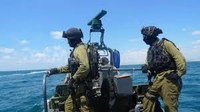
The Israeli Occupation Navy boats Saturday opened their machine gunfire on fishing boats sailing within the unilaterally-imposed six-nautical-miles fishing zone offshore Gaza Strip. No casualties were reported.
The Palestinian Interior Ministry affirmed in a brief report issued Saturday morning that Israeli navy boats targeted Palestinian fishing boats off Gaza northern shores.
The Palestinian fishing boats were forced to leave the sea. No injuries were reported.
Israeli naval boats routinely open fire on Palestinian fishermen sailing within the six-nautical-miles zone and farmlands along the border, flagrantly violating the ceasefire deal.
The Palestinian Interior Ministry affirmed in a brief report issued Saturday morning that Israeli navy boats targeted Palestinian fishing boats off Gaza northern shores.
The Palestinian fishing boats were forced to leave the sea. No injuries were reported.
Israeli naval boats routinely open fire on Palestinian fishermen sailing within the six-nautical-miles zone and farmlands along the border, flagrantly violating the ceasefire deal.
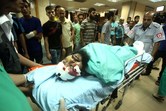
Two Palestinian policemen suffered injuries on Friday evening when an Israeli warplane bombed a training site belonging to al-Qassam Brigades of Hamas in the Gaza Strip.
A spokesman for the health ministry affirmed that two policemen sustained different wounds during an aerial attack on a resistance post in Salahuddin neighborhood near al-Bureij refugee camp.
The Israeli army claimed the air raid had been launched in response to a rocket attack from Gaza.
Spokesman for the occupation army Peter Lerner said in Twitter remarks that three Palestinian rockets were fired on Friday afternoon from the Palestinian territory towards Israel, one of them landed in an open border area inside Israel and two inside Gaza.
A spokesman for the health ministry affirmed that two policemen sustained different wounds during an aerial attack on a resistance post in Salahuddin neighborhood near al-Bureij refugee camp.
The Israeli army claimed the air raid had been launched in response to a rocket attack from Gaza.
Spokesman for the occupation army Peter Lerner said in Twitter remarks that three Palestinian rockets were fired on Friday afternoon from the Palestinian territory towards Israel, one of them landed in an open border area inside Israel and two inside Gaza.
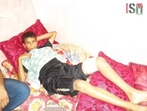
Palestinian medical sources have reported that a child was wounded, late on Friday evening, after Israeli soldiers, stationed across the border fence, opened fire on homes, east of Beit Hanoun, in the northern part of the Gaza Strip.
The sources said that Maher Shatat, 14 years of age, was shot with a live round, suffering a moderate injury, and was moved to a hospital in Beit Hanoun.
The soldiers were stationed across the border fence, in northern Gaza.
On Friday at night, five Palestinians were wounded, including one who suffered a serious injury after the army fire missiles into an area in central Gaza. .
The army claimed the targeted area was an armed resistance training ground.
The sources said that Maher Shatat, 14 years of age, was shot with a live round, suffering a moderate injury, and was moved to a hospital in Beit Hanoun.
The soldiers were stationed across the border fence, in northern Gaza.
On Friday at night, five Palestinians were wounded, including one who suffered a serious injury after the army fire missiles into an area in central Gaza. .
The army claimed the targeted area was an armed resistance training ground.
7 aug 2015
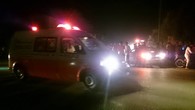
Palestinian medical sources reported
that five Palestinians were injured in an airstrike on Friday at night
targeting a site that they claimed was a resistance training center in
central Gaza.
The Israeli army fired at least one missile at the alleged training grounds, located near al-Nusseirat refugee camp, causing four injuries. The injured were all taken to a local hospital.
Israeli army spokesman Avichai Adraee stated that the army bombarded a Hamas center in Gaza in retaliation for a rocket that was fired into southern Israel. He held the Hamas party fully responsible for any escalation in the region.
The five men who were injured have not been identified - one of them was injured seriously, while three sustained moderate injuries. The fifth sustained a mild injury, but no further details were available at the time of this report as to the extent and type of injuries.
The injured men were all taken to Al Aqsa Hospital in Dir al-Balah, in central Gaza.
IAF strikes Hamas target in Gaza hours after rocket fire
Code red sirens remained silent earlier as rocket landed less than one kilometer from border fence; second projectile apparently fired, landed inside Gaza.
The Israeli Air Force struck a Hamas military post in the central Gaza Strip on Friday night, hours after a rocket fired from the enclave landed in Israeli territory north of Kissufim, just east of the Gaza Strip.
Hamas said one of its facilities was hit and two of its members lightly hurt.
The projectile fired from Gaza earlier in the day landed in an open area less than one kilometer from the Gaza border fence and no damage or injuries were reported.
At least one additional rocket fell inside Gazan territory.
On Thursday night, three rockets were fired at Israel, but exploded inside Gaza adjacent to the border fence in the central and northern strip.
An hour before the rocket fire, Gaza Division Commander Brigadier-general Itay Virov met with 52 lone soldiers at Kibbutz Magen. Virov told the soldiers that a year after Operation Protective Edge, the southern front is relatively quiet, even though the IDF deals with occasional attempts by elements within the Gaza Strip to disturb the peace through sporadic rocket fire.
Code red sirens were not triggered by the launch and IDF forces arrived in the area to try to find the mortar.
Residents said they heard neither the rocket or code red sirens.
The Israeli army fired at least one missile at the alleged training grounds, located near al-Nusseirat refugee camp, causing four injuries. The injured were all taken to a local hospital.
Israeli army spokesman Avichai Adraee stated that the army bombarded a Hamas center in Gaza in retaliation for a rocket that was fired into southern Israel. He held the Hamas party fully responsible for any escalation in the region.
The five men who were injured have not been identified - one of them was injured seriously, while three sustained moderate injuries. The fifth sustained a mild injury, but no further details were available at the time of this report as to the extent and type of injuries.
The injured men were all taken to Al Aqsa Hospital in Dir al-Balah, in central Gaza.
IAF strikes Hamas target in Gaza hours after rocket fire
Code red sirens remained silent earlier as rocket landed less than one kilometer from border fence; second projectile apparently fired, landed inside Gaza.
The Israeli Air Force struck a Hamas military post in the central Gaza Strip on Friday night, hours after a rocket fired from the enclave landed in Israeli territory north of Kissufim, just east of the Gaza Strip.
Hamas said one of its facilities was hit and two of its members lightly hurt.
The projectile fired from Gaza earlier in the day landed in an open area less than one kilometer from the Gaza border fence and no damage or injuries were reported.
At least one additional rocket fell inside Gazan territory.
On Thursday night, three rockets were fired at Israel, but exploded inside Gaza adjacent to the border fence in the central and northern strip.
An hour before the rocket fire, Gaza Division Commander Brigadier-general Itay Virov met with 52 lone soldiers at Kibbutz Magen. Virov told the soldiers that a year after Operation Protective Edge, the southern front is relatively quiet, even though the IDF deals with occasional attempts by elements within the Gaza Strip to disturb the peace through sporadic rocket fire.
Code red sirens were not triggered by the launch and IDF forces arrived in the area to try to find the mortar.
Residents said they heard neither the rocket or code red sirens.

A rocket previously launched in Israel
Code red sirens remain silent as mortar round lands less than one kilometer from border fence; second projectile apparently fired, landed inside Gaza.
A mortar round fired from Gaza Friday afternoon landed in Israeli territory north of Kissufim, just east of the Gaza Strip.
The projectile landed in an open area less than one kilometer from the Gaza border fence and no damage or injuries were reported.
At least one additional rocket fell inside Gazan territory.
On Thursday night, three rockets were fired at Israel, but exploded inside Gaza adjacent to the border fence in the central and northern strip.
An hour before the rocket fire, Gaza Division Commander Brigadier-general Itay Virov met with 52 lone soldiers at Kibbutz Magen. Virov told the soldiers that a year after Operation Protective Edge, the southern front is relatively quiet, even though the IDF deals with occasional attempts by elements within the Gaza Strip to disturb the peace through sporadic rocket fire.
Code red sirens were not triggered by the launch and IDF forces arrived in the area to try to find the mortar.
Residents said they heard neither the rocket or code red sirens.
Code red sirens remain silent as mortar round lands less than one kilometer from border fence; second projectile apparently fired, landed inside Gaza.
A mortar round fired from Gaza Friday afternoon landed in Israeli territory north of Kissufim, just east of the Gaza Strip.
The projectile landed in an open area less than one kilometer from the Gaza border fence and no damage or injuries were reported.
At least one additional rocket fell inside Gazan territory.
On Thursday night, three rockets were fired at Israel, but exploded inside Gaza adjacent to the border fence in the central and northern strip.
An hour before the rocket fire, Gaza Division Commander Brigadier-general Itay Virov met with 52 lone soldiers at Kibbutz Magen. Virov told the soldiers that a year after Operation Protective Edge, the southern front is relatively quiet, even though the IDF deals with occasional attempts by elements within the Gaza Strip to disturb the peace through sporadic rocket fire.
Code red sirens were not triggered by the launch and IDF forces arrived in the area to try to find the mortar.
Residents said they heard neither the rocket or code red sirens.
6 aug 2015
|
|
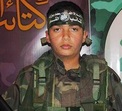
Bakr Hasan Abu Naqira,
Abdul-Rahman Abu Naqira, (photo) Ahmad Hasan Abu Naqira, Hassan Ahmad Abu Naqira. At least four Palestinians were killed on Thursday and over 30 injured when an unexploded ordnance from last summer's Israeli military offensive went off while clearing rubble from a destroyed house in the southern Gaza Strip, medics said. Palestinian medical sources at the Abu Yousif al-Najjar hospital in Rafah said four bodies and multiple wounded Palestinians arrived at the emergency room. The victims, who were all from the same family, were identified as |
Bakr Hasan Abu Naqira, Abdul-Rahman Abu Naqira, Ahmad Hasan Abu Naqira, and Hassan Ahmad Abu Naqira.
Medics said it is likely that the death toll will increase. Over 7,000 unexploded ordnance were left throughout the Gaza Strip following last summer's war between Israel and Palestinian militant groups, according to officials of the UN Humanitarian Coordinator for the Palestinian territories (OCHA).
Even before the most frequent Israeli assault, unexploded ordnance from the 2008-9 and 2012 offensives was a major threat to Gazans.
A 2012 report published by the Office of the High Commissioner for Human Rights said that 111 civilians, 64 of whom were children, were casualties to unexploded ordnance between 2009 and 2012, reaching an average of four every month in 2012.
Medics said it is likely that the death toll will increase. Over 7,000 unexploded ordnance were left throughout the Gaza Strip following last summer's war between Israel and Palestinian militant groups, according to officials of the UN Humanitarian Coordinator for the Palestinian territories (OCHA).
Even before the most frequent Israeli assault, unexploded ordnance from the 2008-9 and 2012 offensives was a major threat to Gazans.
A 2012 report published by the Office of the High Commissioner for Human Rights said that 111 civilians, 64 of whom were children, were casualties to unexploded ordnance between 2009 and 2012, reaching an average of four every month in 2012.
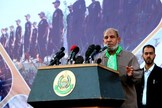
Senior Hamas official Mahmoud al-Zahhar has warned that the ceasefire that took effect following Israel's last war on the Gaza Strip could not survive if the blockade on its impoverished population persisted.
Zahhar made his remarks during a graduation ceremony held for the young men participating in the summer training camps of al-Qassam Brigades, the armed wing of Hamas.
The Hamas official emphasized in a speech during the ceremony that the price for solidifying the fragile truce with the occupation is to end its blockade on Gaza.
He accused the Israeli occupation and the Palestinian Authority of being together responsible for delaying the reconstruction of the war-torn enclave.
Zahhar also hailed that the Palestinian resistance for teaching the Israeli occupation a lesson during al-Asef al-Makoul battle in 2014 about the impossibility of invading Gaza, and paid tribute to the Palestinians in occupied Jerusalem for their steadfastness in the face of the ongoing Jewish violations at the Aqsa Mosque.
Zahhar made his remarks during a graduation ceremony held for the young men participating in the summer training camps of al-Qassam Brigades, the armed wing of Hamas.
The Hamas official emphasized in a speech during the ceremony that the price for solidifying the fragile truce with the occupation is to end its blockade on Gaza.
He accused the Israeli occupation and the Palestinian Authority of being together responsible for delaying the reconstruction of the war-torn enclave.
Zahhar also hailed that the Palestinian resistance for teaching the Israeli occupation a lesson during al-Asef al-Makoul battle in 2014 about the impossibility of invading Gaza, and paid tribute to the Palestinians in occupied Jerusalem for their steadfastness in the face of the ongoing Jewish violations at the Aqsa Mosque.
4 aug 2015
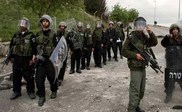
The Israeli Occupation Forces (IOF) carried out Tuesday morning a limited incursion into the eastern areas of Khan Younis to the south of Gaza strip.
Five Israeli military vehicles were observed by local residents penetrating 150 meters into Qarara border town northeast of Khan Younis, PIC reporter said.
Today's incident came as part of Israeli near-daily violations to the ceasefire agreement reached on August 26, 2014 between Palestinian resistance and Israel to end its 51-day aggression on Gaza.
Five Israeli military vehicles were observed by local residents penetrating 150 meters into Qarara border town northeast of Khan Younis, PIC reporter said.
Today's incident came as part of Israeli near-daily violations to the ceasefire agreement reached on August 26, 2014 between Palestinian resistance and Israel to end its 51-day aggression on Gaza.
2 aug 2015

The Israeli occupation forces (IOF) on Sunday morning opened fire at Palestinian farmers and fishermen in different locations of the Gaza Strip, with no reported casualties.
Local sources told Quds Press that Israeli border troops opened machinegun fire heavily at farmers and homes to the east of Johr Addik area and al-Maghazi refugee camp.
They also reported unusual military moves amid intensive drone overflights along the eastern border of Gaza.
The Israeli navy also opened machinegun fire this morning at Palestinian fishing boats off the northern coast of Gaza.
The intensity of shooting forced the fishermen on these boats to return to the shore.
Local sources told Quds Press that Israeli border troops opened machinegun fire heavily at farmers and homes to the east of Johr Addik area and al-Maghazi refugee camp.
They also reported unusual military moves amid intensive drone overflights along the eastern border of Gaza.
The Israeli navy also opened machinegun fire this morning at Palestinian fishing boats off the northern coast of Gaza.
The intensity of shooting forced the fishermen on these boats to return to the shore.
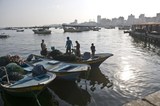
Israeli naval forces on Sunday morning fired gunshots at Palestinian fishermen sailing off the coast of the Gaza Strip, witnesses said.
Witnesses said the forces fired machine guns at Palestinian fishing boats off the coast of al-Waha as well Sudaniyya located in the northwestern Gaza Strip, adding that no injuries were reported.
An Israeli army spokesperson had no immediate information and told Ma'an she would look into the incident.
Palestinian fishermen face daily risks in order to make a living, including routine harrassment from Israeli naval forces, confiscation of boats and materials, detention, and potentially death.
At least three Palestinian fishermen have been shot dead by Israeli forces since September.Israeli forces often allege that fishermen deviate from the designated fishing zone and pose a security threat.
The exact limits of the zone set by Israeli authorities are often ambiguous and Israeli authorities have not abided by the fishing zone agreed upon in last summer's ceasefire agreement, rights groups say.
The attacks come despite Israeli promises at the end of the ceasefire to ease restrictions on Palestinian access to both the sea and the border region near the "security buffer zone."
Witnesses said the forces fired machine guns at Palestinian fishing boats off the coast of al-Waha as well Sudaniyya located in the northwestern Gaza Strip, adding that no injuries were reported.
An Israeli army spokesperson had no immediate information and told Ma'an she would look into the incident.
Palestinian fishermen face daily risks in order to make a living, including routine harrassment from Israeli naval forces, confiscation of boats and materials, detention, and potentially death.
At least three Palestinian fishermen have been shot dead by Israeli forces since September.Israeli forces often allege that fishermen deviate from the designated fishing zone and pose a security threat.
The exact limits of the zone set by Israeli authorities are often ambiguous and Israeli authorities have not abided by the fishing zone agreed upon in last summer's ceasefire agreement, rights groups say.
The attacks come despite Israeli promises at the end of the ceasefire to ease restrictions on Palestinian access to both the sea and the border region near the "security buffer zone."
1 aug 2015
Two rockets fired from Gaza Strip land in border fence area
Two rockets fired from the Gaza Strip fell in the border fence area in the northern strip late Saturday night. Law enforcement has begun searching to see whether any projectiles fell in Israeli territory. No sirens were sounded.
Two rockets fired from the Gaza Strip fell in the border fence area in the northern strip late Saturday night. Law enforcement has begun searching to see whether any projectiles fell in Israeli territory. No sirens were sounded.
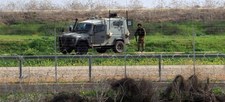
The Israeli occupation army on Friday intensified its military presence along the Gaza border for fear of reprisals from the Palestinian resistance following the settlers' deadly arson attack on a Palestinian family in Nablus.
An informed local source told Quds Press that the Israeli army started yesterday afternoon to dispatch more troops along the eastern and northern borders of Gaza.
He expressed his belief that the Israelis fear that the resistance in Gaza might carry out attacks against Israeli targets in retaliation to the death of a Palestinian toddler and the injury of his family in Nablus during an arson attack on their house by Jewish settlers.
These military deployments and moves have been taking place concurrently with sporadic Israeli gunfire attacks on populated areas to the east of Gaza.
An informed local source told Quds Press that the Israeli army started yesterday afternoon to dispatch more troops along the eastern and northern borders of Gaza.
He expressed his belief that the Israelis fear that the resistance in Gaza might carry out attacks against Israeli targets in retaliation to the death of a Palestinian toddler and the injury of his family in Nablus during an arson attack on their house by Jewish settlers.
These military deployments and moves have been taking place concurrently with sporadic Israeli gunfire attacks on populated areas to the east of Gaza.
31 july 2015
|
|
Mohammad Hamid al-Masri,17
Israeli forces killed a Palestinian and injured another on Friday after opening fire at them near Beit Lahiya in northern Gaza, sources told Ma'an. Medical sources told Ma'an that Mohammad Hamid al-Masri,17, was shot by Israeli forces and died instantly, and another Palestinian was moderately wounded. Witnesses said the two were shot suddenly while walking near the buffer zone. An Israeli spokesperson said "two suspects approached the security fence" near the buffer zone in the northern Gaza strip. According to the spokesperson, Israeli forces told the two to halt, then fired shots into the air. The spokesperson said one of the men continued toward the fence "in spite of repeated warning, so the [Israeli] forces fired towards the lower extremities of the suspect." |
The spokesperson added that after the hit, the two suspects were then seen moving away from the fence.
Israeli forces opened fire towards civilians in the "security buffer zone" on land and at sea on at least 23 occasions during the last two weeks, according to the United Nations Office for Coordination of Humanitarian Affairs. On two occasions, Israeli forces entered and leveled land near the fence inside the Gaza Strip.
Israeli forces opened fire towards civilians in the "security buffer zone" on land and at sea on at least 23 occasions during the last two weeks, according to the United Nations Office for Coordination of Humanitarian Affairs. On two occasions, Israeli forces entered and leveled land near the fence inside the Gaza Strip.
30 july 2015
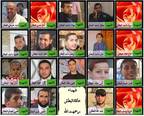
Mo’men Al-Batsh (picture Al-Batsh family)
On Wednesday morning, a man's body was found under the rubble in Gaza, one year after the Israeli assault, during bulldozing works.
Locals said that Mo’men Al-Batsh was found one year after his death under the rubble in Hayy Al-Tuffah, east of Gaza city.
18 members of Al-Batsh family were killed during last year’s Israeli genocide on Gaza. Of the 18, six were children, and three were women, including one pregnant woman.
Sixteen others were injured, including three children and three women. Four of the injuries were described by medical sources as “critical.”
On Wednesday morning, a man's body was found under the rubble in Gaza, one year after the Israeli assault, during bulldozing works.
Locals said that Mo’men Al-Batsh was found one year after his death under the rubble in Hayy Al-Tuffah, east of Gaza city.
18 members of Al-Batsh family were killed during last year’s Israeli genocide on Gaza. Of the 18, six were children, and three were women, including one pregnant woman.
Sixteen others were injured, including three children and three women. Four of the injuries were described by medical sources as “critical.”
Truce violations List of names Pictures of martyrs
Days: Aug: 26 - 25 - 24 - 23 - 22 - 21 - 20 - 19 - 18 - 17 - 16 - 15 - 14 - 13 - 12 - 11 - 10 - 9 - 8 - 7 - 6 - 5 - 4 - 3 - 2 - 1
July: 31 - 30 - 29 - 28 - 27 - 26 - 25 - 24 - 23 - 22 - 21 - 20 - 19 - 18 - 17 - 16 - 15 - 14 - 13 - 12 - 11 - 10 - 9 - 8
